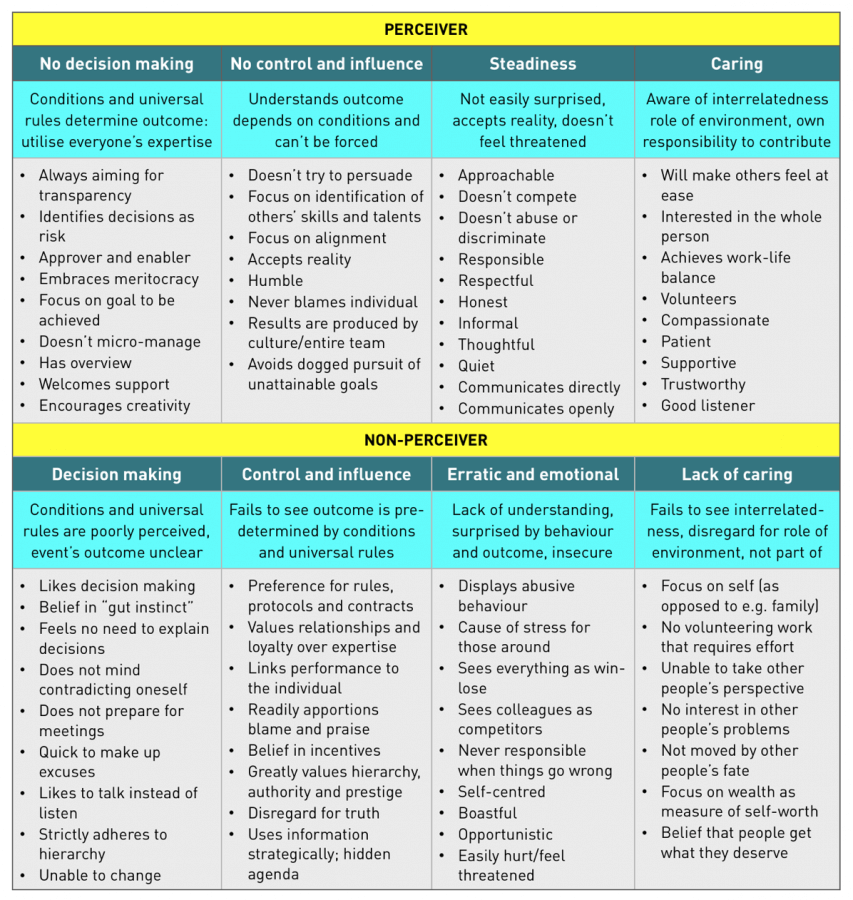Leadership performance is easy to predict.
The dictionary defines a leader as “a person who leads or commands a group, organisation or country”, and leadership as “the action of being a leader”. If we want to talk about “leadership qualities”, however, we must first establish what it is that leaders should achieve. When does a leader actually lead? The dictionary defines leading as “to set (a process) in motion”. But what is it that has to be set in motion, and to what aim?
Decision Free Solutions defines the “action of leading” as follows:

The “action” of leading, the process to be set in motion, is creating, sustaining and communicating a culture (within a team, project, organisation, whatever) which provides the conditions required to achieve the desired outcome against minimal risk.
The implicit statement this definition makes is that those who take on the leadership-role must care. The one who takes on the leadership-role is to achieve a desired outcome for someone or something else (i.e. the organisational unit), and to create the required conditions for others. In the end, it is the collective behaviour and attitude of all those who take on the leadership-roles in an organisation that determines how it goes about achieving desired outcomes, and how the organisation relates to its employees, its customers and its environment.
The approach of Decision Free Solutions can only be implemented successfully if an organisation is able to identify the individuals who have the right combination of characteristics and experience suited to lead within their environment (be it in the boardroom, a department, a project or a team). How this can be achieved is explained in detail in the DFS-publication “Leadership explained”. Next, a brief overview of the logic involved is provided.
The skills needed to successfully fulfil the leadership-role vary immensely from situation to situation. Taking on this role generally means having to deal with changing environments and new unique challenges. But also in what are otherwise stable environments anything which is out of the ordinary will be escalated up the hierarchy.
At every level within the organisation these leadership-role responsibilities translate to different tasks requiring different talents. But there is one talent or trait that is needed in all of these situations: a high level of perceptiveness.
“Leadership explained” goes on to identify four Leadership-types based on their experience and level of perceptiveness (Unsuited, Skilled, Perceiver, Magician), and four types of Environments based on complexity (number of “Universal rules”) and transparency (to what extent the environment one operates is is actually known). For each of the four environments (Stable, Complex, Dynamic, Chaotic) a certain Leadership-type is most likely to be successful. The most important characteristic is a high level of perceptiveness.

The concept that the level of perceptiveness can be observed (and future behaviour predicted) was introduced by Dean Kashiwagi. It is explained in detail — both for individuals and for organisations — in “How to predict future behaviour of individuals and organisations“. Perceptiveness, as mentioned earlier, differs from mere observation in that it comes with a type of curiosity. A drive to understand, an innate interest in discovering what is cause and what is effect.
Using the Event model (see glossary) it is explained how someone with a high level of perceptiveness:
- Will try to avoid the making of choices which are not fully substantiated, as it means that expertise is lacking (no decision making)
- Understands that exerting “control and influence” will not change the outcome of an event (No control and influence)
- Will accept reality, and draw lessons from any unexpected development — come what may, such a person will behave in an emotional stable way (Steadiness)
- Will be more aware of how someone’s environment plays a decisive role in someone’s “outcome”, and how so many things are interrelated (Caring).
Someone’s level of perceptiveness translates into correlated behavioural characteristics. Many of these are easy to observe, others — because of the correlation — can readily be assumed or predicted. In the table below behavioural characteristics for someone with a high (PERCEIVER) and a low (NON-PERCEIVER) level of perceptiveness are grouped.
In summary:
- Someone’s level of perceptiveness can be observed
- Someone’s level of perceptiveness, in combination with their experience, allows one to determine their “Leadership-type”
- Based on the environment type someone is to take on a leadership-role, it can thus be predicted whether he/she is likely to do well in this role

To stay ahead, freeing up resources beats cutting cost.
To stay ahead relying on quality alone is not enough. But the approach of "cutting cost" results in reduced quality and margins. Utilise expertise to free up resources instead. Cost reduces, and margins increase.
Read moreThe alternative to decision making is transparency.
Decisions are conclusions reached after careful thought. When something requires 'thinking' it is not transparent. Transparency allows organisations to manage by approval (instead of decisions).
Read moreEverybody can manage risk, only few can minimise it.
In every organisation there are both identified and unidentified risks. To manage identified risks is straightforward. Everybody can manage identified risks. Which leaves the unidentified risks. Who will minimise these? Not everybody can.
Read moreLeadership performance is easy to predict.
In every leadership-role the aim is to create the conditions to achieve the aims against minimal risk. The needed combination of experience and skills is always different. Simple observations help to identify the right person.
Read more